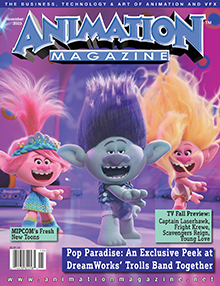|
Getting your Trinity Audio player ready...
|
After winning numerous festival awards over the past two years, Signe Baumane’s acclaimed feature My Love Affair with Marriage will finally get a theatrical run this month in the U.S. thanks to distributor 8 Above. This second hand-drawn feature from the Latvian-born, Brooklyn-based animation artist centers on a spirited young woman determined to find love in the bewildering modern world.
Features the voices of Matthew Modine, Dagmara Domińczyk, Michele Pawk, Cameron Monaghan and Stephen Lang, the film had its world premiere at the 2022 Tribeca Film Festival, and has since screened at over 90 films festivals world and won over 20 awards, including the Grand Prix at Animafest Zagreb.
Baumane was kind enough to answer a few of our questions in a recent email interview:

Animation Magazine: Congrats on the ongoing success of your funny, poignant and personal movie. Can you please give us some background about it?
Signe Baumane: I made a lot of short films about sex and I made one feature film about depression. In my new film, I want to combine the two themes — so I am making a film about marriage. After my first animated feature film Rocks in My Pockets, I wanted to make a film about my second marriage to a self-described gender-bending man, a fellow animator. I thought it was a very dramatic story of how we project our desires and hopes on another person. Early in the process of writing it, I got distracted by a question: “Why did we want to marry?” I had to investigate. That led to the whole history of a young woman’s search for love.
When did you begin work on it and how long did it take to produce?
I started writing the script in September 2015. It took a year and two months to write it, because I also had to do science research. Then we had to put some funding together and find partnerships. We started production in earnest in 2017 and continued it through the pandemic until June 2021. The post production took another year.
How many people worked on the movie with you?
The production really settled in around late 2018 and then we had pretty good teams collaborating in Brooklyn, U.S. and Riga, Latvia. We had a team of six people in Brooklyn — building sets, coloring, lighting, photographing, animating, shading, scanning drawings. etc.. etc. In Latvia a team of 10 artists colored the animation drawings in Photoshop with an emphasis on artistic shadows and a team of five compositors put the animation together with stop-motion backgrounds.

What are you most pleased about with the finished movie?
One of my favorite things about My Love Affair with Marriage is the music by Kristian Sensini. He wrote 23 distinct songs, and an amazing score. I love how the “Biology” music in the opening scene draws us into the story, and the end-credit song (sung by Storm Large) closes the story with a feeling of hope and possibilities. I also love the “Biology” animation segments, animated by Yajun Shi. Her particular style adds to the style of the rest of the film and still stands apart as a separate space, the world of biology. Yajun’s “Biology” segments evoke a sense of mystery.
What was the most challenging aspect of making the movie?
Definitely having to constantly fundraise. I always wished to disappear in the creative process, to think only about the characters and how to animate them, but every few months or so we had to get creative about fundraising. The other challenge was: How do you keep motivated when making a film takes seven years? There would be times when I would raise my head after animating for a year and see that I only made 15 minutes with 90 more to go and I would start screaming (internally, of course, but it would be a desperate howl of a wounded animal). I am an impatient person, I want everything to be done yesterday.
Can you name some of your animation idols?
Hayao Miyazaki, Joanna Quinn, Jan Švankmajer, Bill Plympton, Michaela Pavlátová.
When did you realize that you wanted to work in animation?
After studying philosophy for five years at Moscow State University, I was supposed to go back to Latvia and teach philosophy — and, for many reasons, I didn’t want to do that. My friend Irina, who later became a famous singer in Russia, pointed out that instead of writing down the lectures I filled my notebooks with doodles. “I want to see them move,” she said. “Why don’t you go into animation?” As I was organizing my doodles into storyboards I realized this was it. This was the thing I was born to do.
And what was the biggest lesson you learned from this movie?
When we started the project back in 2015, we thought the next year we would have a woman president in the U.S.A. Since then, we had many major movements, societal upheavals, backlashes — and, now, a horrifying Russian invasion of Ukraine. Sometimes it was hard to sit at the table and animate when the world seemed to be either falling apart or moving in a new direction. But I did have a feeling that the film is relevant to our current times. The biggest take away from this experience is that the connection between me and the film’s 1,685 backers via our regular newsletters and their response to those newsletters was an absolute necessity in the process. Our supporters’ trust in me and the project carried me through the doubt and uncertainty. It made the lonely process of animating less lonely and assured me and our team that we were on the right track.
What is your take on the broader animation landscape today, especially compared to when you started out?
It is a complex, big question that requires a thoughtful and sophisticated answer — I am only an independent animator playing in my own sandbox. I am happy to see that there are more and more women directors directing animated feature films and there are more women-centric stories. My pet peeve is that animation is considered by mainstream media and general audiences as a medium exclusively for children, dismissing the amazing potential of what animation can do for adult audiences.
A new development in the industry is that with all the streamers, VODs and SVODs, etc., etc., a film is now called “content” and the filmmaker/artist a “content creator.” I think once you buy into this notion that you are making “content,” you dismiss yourself as an artist. An artist’s mission is to break new ground, to discover new vistas, new possibilities for the art form and for society. A content creator’s mission is to make money by remaking what has been already made. An artist’s mission is to challenge existing paradigms, aspire for new discoveries.
What do you hope audiences will take away from your movie?
I hope the audiences will walk out of the film humming the end credits song “Lion,” charged with hope, understanding and desire to make the world a better place, starting with themselves.
My Love Affair with Marriage makes its U.S. theatrical debut October 6 at The Quad in New York, followed by Los Angeles engagements at the Laemmle Royal (Oct. 12 preview) and Laemmle Glendale (Oct. 13), before arriving in additional cities.
You can find out more at myloveaffairwithmarriagemovie.com.
















